I’m not fond of cliches like “game changer.” However, here we have a product that claims to allow you to drop a brand new chain straight into a pot of molten wax, thick factory grease and all. There’s no worrying about getting a chain white-glove clean, and no degreasing at all required beforehand. Nope, just drop the chain straight in and then the benefits of wax await. Sounds like a game changer, no?
For some cyclists, the claim could mean never using degreasers again, while for others, it may remove one of the biggest barriers to adopting chain waxing at all. That’s the goal of Silca’s new StripChip, a product that looks more like an artisanal chocolate bar than a group ride’s conversation point.
Wax 101
The concept of lubricating a chain in molten paraffin wax has existed for decades. However, it wasn’t until the test labs of FrictionFacts and, later, Zero Friction Cycling that new attention was brought to how good the old-school concept could be (with a few newer-tech low-friction additives tossed into the mix). Since then, we’ve seen the likes of Silca, Absolute Black, Cyclowax, and others join Molten Speed Wax with cycling-specific melt-on chain wax products.
In a nutshell, hot chain waxing ensures lubricant penetrates the chain links where it’s needed, instead of just sitting on the outside. Once cool, the wax provides a highly effective dry-to-touch coating that is both low-friction and keeps the exposed chain clean. When done correctly, the process improves drivetrain efficiency – good for the watt weenies – but it also dramatically increases drivetrain longevity. It’s common to hear of cyclists getting 15,000-20,000 km out of a bicycle chain, and significantly more than that from cassettes and chainrings. The drivetrain also no longer gets greasy, and if it needs cleaning, you only need some boiled water to get a waxed chain back to sparkling.
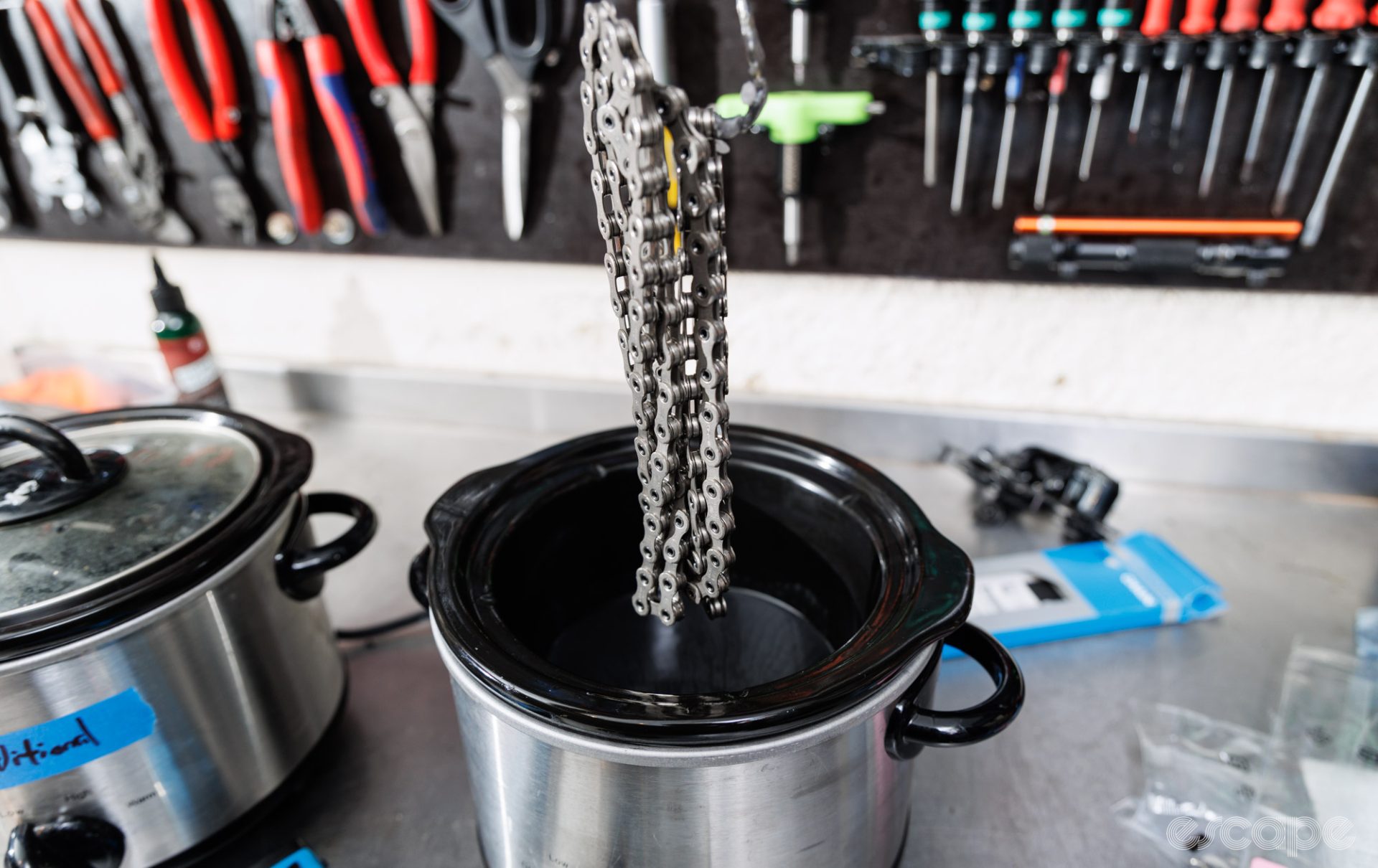
However, waxing is still deemed by many to be a faff. The biggest barrier is that the chain must first (and only once) be degreased until it’s free from all oils, which can be a process given the stubbornness of factory-applied chain greases. You then need a way to heat the wax, but ideally, do so without getting it too hot. And of course, you need to remove the chain from the bike to get it into the hot wax pot or bag.
The StripChip
Silca certainly didn’t create the hot melt wax market, but they’ve arguably been the most successful in growing it, and that growth all began during the pandemic. Today, the company has two versions of melt-on wax; a wax-based drip lube that can be used by itself or as an on-bike top-up to the hot wax; and a degreaser that claims to easily (and quickly) get a chain ready for wax. These are all solid products, however I’d argue that the StripChip is Silca’s first wax product that’s truly disruptive.
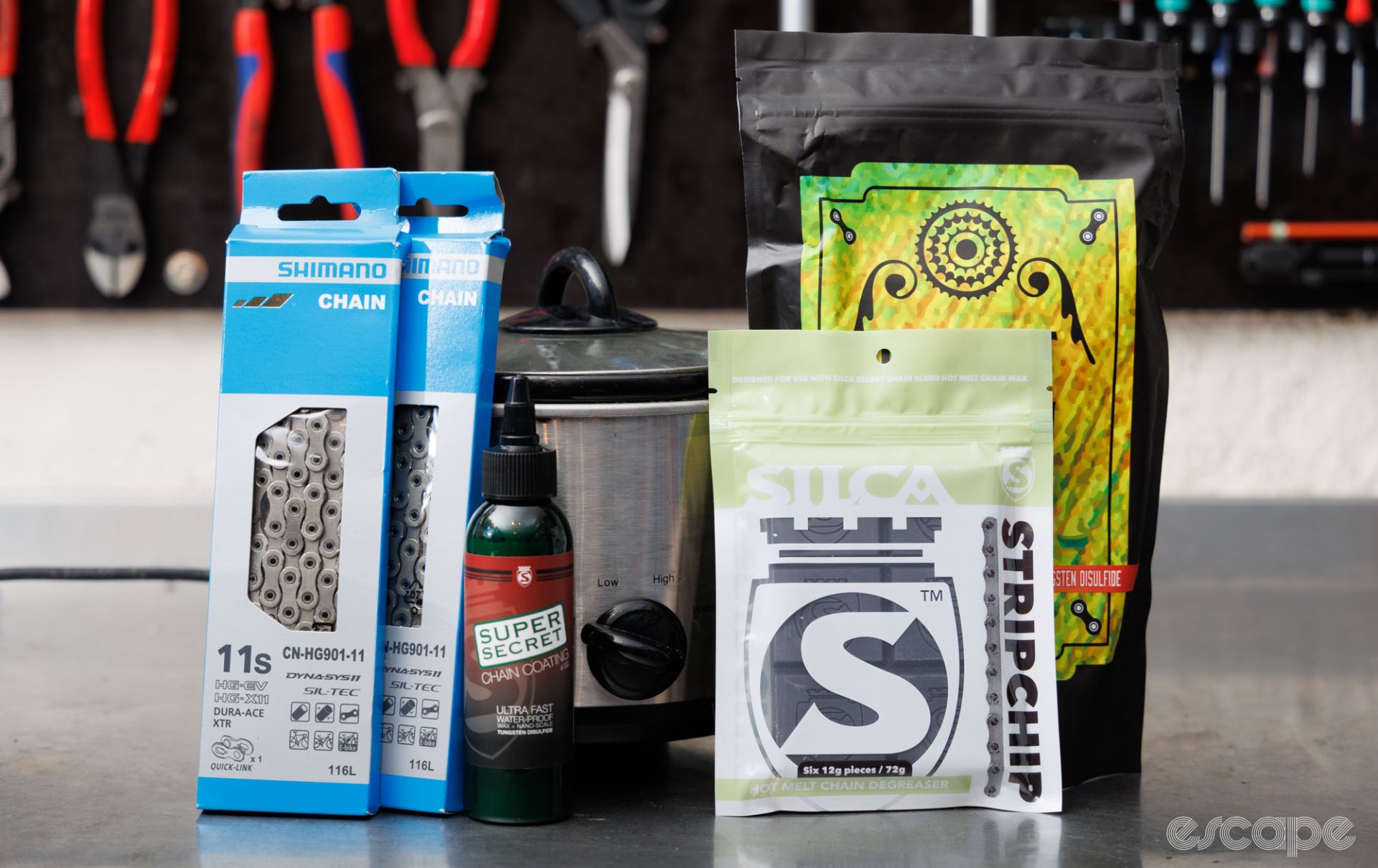
Unlike those at the Purdue University in Indiana who collaborated with Silca on this product, I lack the PhD in chemistry to understand and correctly explain the ‘how’ behind the StripChip. Still, I’ll give it a crack [We have faith in you, Dave – Ed.]. Fundamentally, the StripChip is based on the growing science of oleogelation, which is set to be a big thing in the food industry as a healthier alternative to hydrogenation in creating solids out of oils. Or, as my small brain understands it, the StripChip contains a high percentage of unicorn tears (oleogels), which attach to oil, turning them into a harder long-chain fatty acid that more closely mimics the paraffin wax [Nailed it, Dave – Ed.].
The oil from a factory-greased chain isn’t being magically vanished like the subject of David Blaine, but rather, its composition is changed to better match the hardness of the wax. According to Silca owner Josh Poertner, StripChip is composed entirely of food-safe ingredients, except for the friction-reducing tungsten disulfide additive that makes it taste like shit (ok, Poertner didn’t say that last part).
Silca is selling the chocolate-looking StripChip in a block that contains six chips, each good for one factory-greased chain. At US$24 / £24 / €29 a packet, it costs US$4 per fresh chain to use the StripChip. By comparison, using Silca’s ChainStripper degreaser costs closer to US$2.5-$3 a chain, and harsher store-bought chemicals would be about half that again (assuming you buy medium-sized bottles). And it’s worth stating again that any future cleaning to a waxed chain should only require hot (boiling) water.

In a candid conversation, Poertner shared some finer details related to StripChip. Each StripChip is sized to provide the needed unicorn tears to (approximately) match the quantity of oil/grease within a fresh chain (typically 5.5-6 grams for most 116 link chains). Chains with more or less links will sway this balance, but as a percentage to the 300 grams (or thereabouts) of wax, Poertner suggests the grease in those extra links is not enough to make a measurable difference.
I expressed concern over the type of factory grease differing between chain manufacturers, but Poertner suggests it’s predominately a viscosity difference and that StripChip has been tested with all major chain brands.
As you may as well, I had grand ideas that the StripChip could be used to clean up wax from oil contamination, and therefore, you could degrease chains to a decent level but not stress about them being sterile. Unfortunately, that’s not quite the case. Adding a StripChip into a pot of wax without the 5-6 grams of grease from a fresh chain will make the wax harder than ideal, which, Poertner suggests could lead to a chain that skips in smaller gears when ridden in cold conditions. Perhaps the remaining grease of 5 or 10 chains may be enough to offset the StripChip, but it’s really a guessing game at that point.
And if the product has given you the idea to add a factory-greased chain into your wax pot (without said StripChip), then you’ll be making that wax soft and tacky. The result will be wax that’s pushed out of the links more readily, all while collecting more dirt – neither are good things.
To summarise, Silca suggests you either degrease the chain correctly before waxing or use a StripChip with a fresh factory-greased chain.
First tests
A few weeks ago, I received a fresh bag of Silca Secret Blend wax and a production StripChip block.
The StripChip requires a much higher operating temperature than what you’d normally use to melt wax – 125°C instead of 75°C. That’s partly because the unicorn tears are less effective at lower temperatures, but mostly because those higher temperatures help melt and flush out the factory grease from the chain. A regular slow cooker will achieve such temperatures, but care is needed as the window to over-heating the wax is just 20-25°C away.
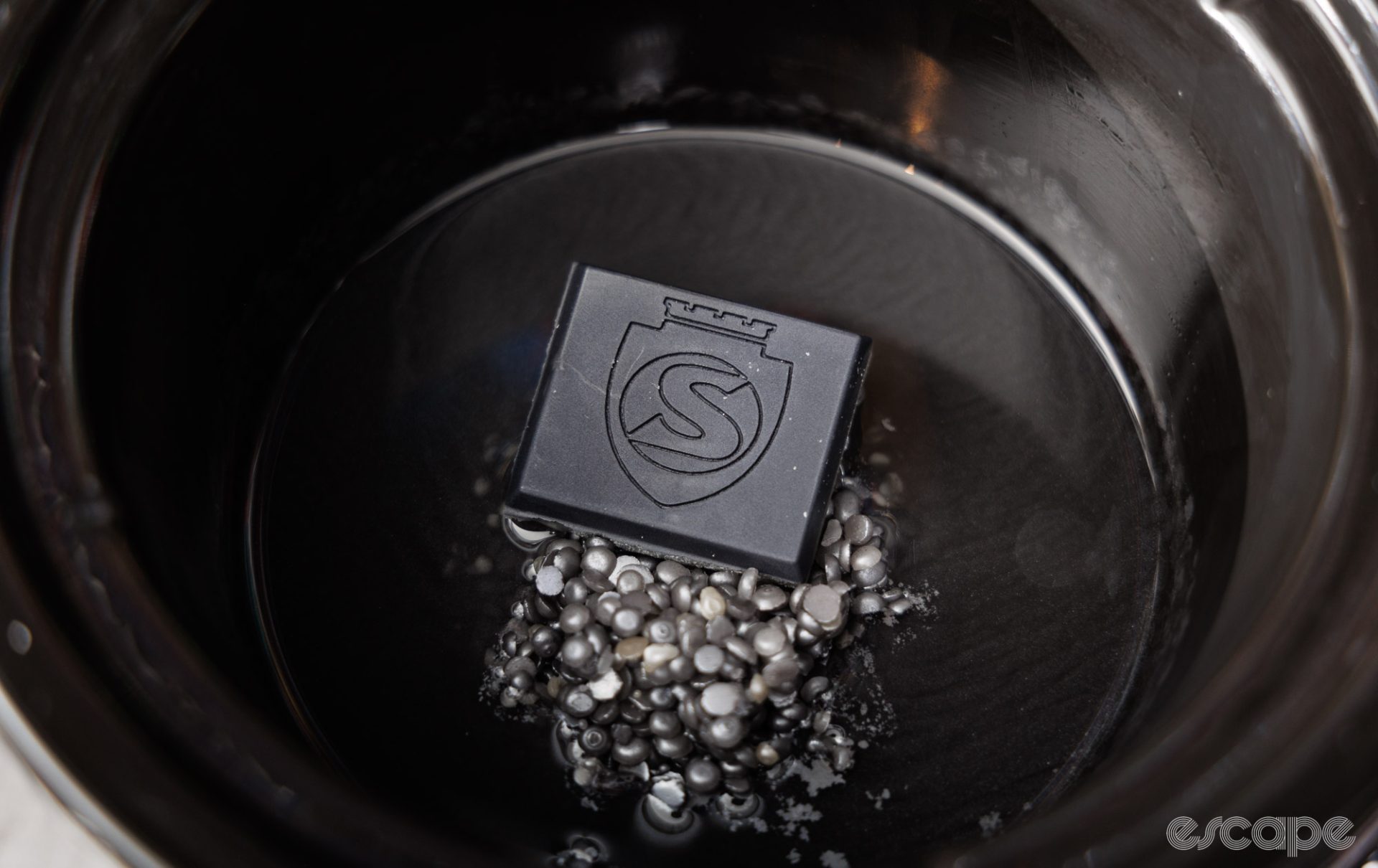
To test, I set up two of the same 1.5L slow cooker models. One was filled with 300 grams of Silca’s Secret Blend wax (the suggested amount within the StripChip instructions), and the other with the remaining wax from the same bag.
I then took two brand-new Shimano HG-901 Dura-Ace 11-speed chains. Coated with its factory grease and all, one went straight into the fresh wax with a block of the chocolate StripChip, heated to the recommended hotter temperature of 125°C. The second chain went through my usual multi-stage degreasing to get a chain sterile for traditional waxing, before being put into its pot of fresh wax at 75°C.
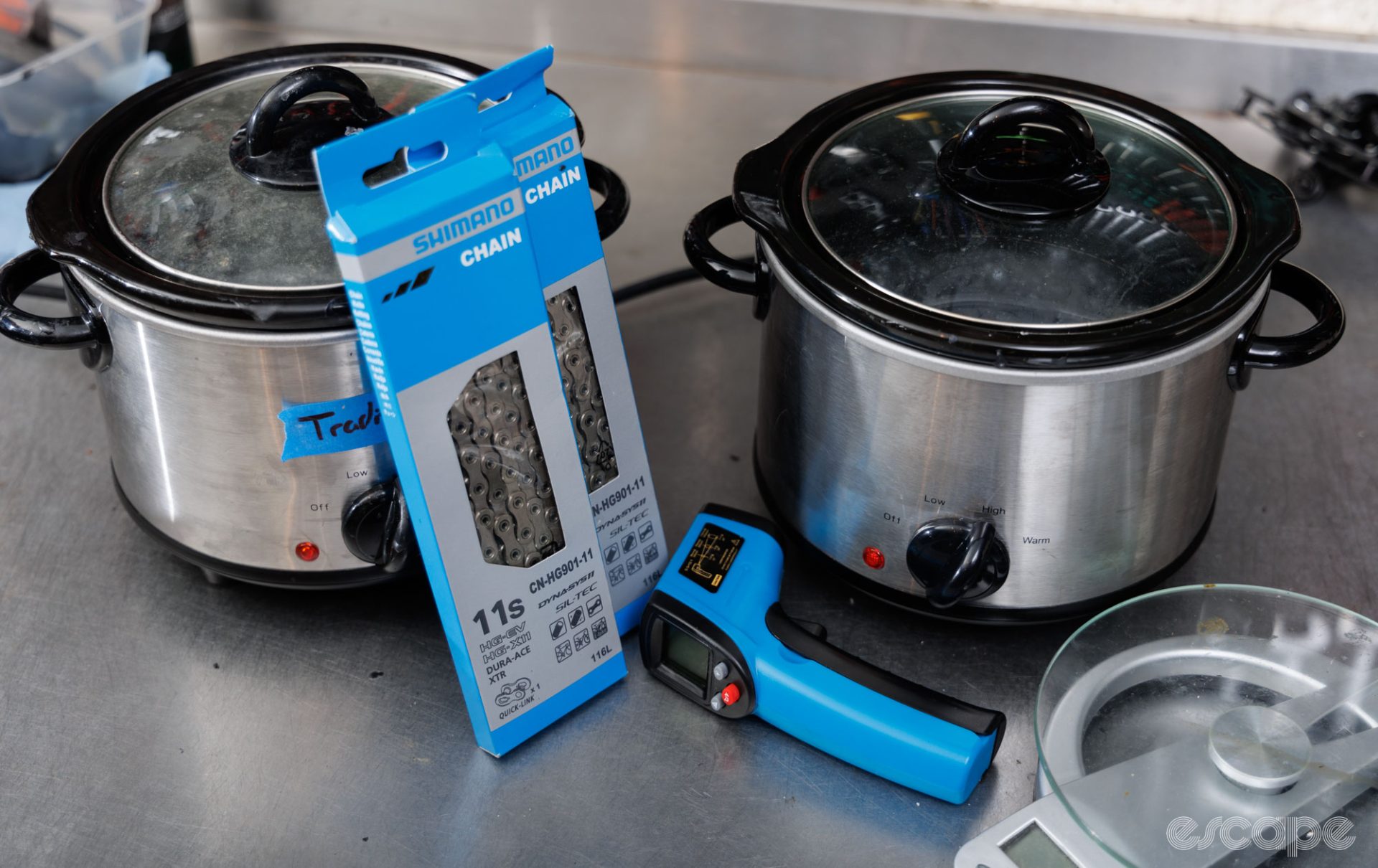
Silca’s instructions involve putting the greasy chain into the wax, agitating, and then letting it sit for 10 minutes at 125°C. The process continues with more agitating and then letting the wax cool to 75°C (about 15 minutes in my well-insulated slow cooker). With the cook done, there were some immediate differences to note.
A chain given the traditional cleaning prep before waxing will cool to be rather rigid, requiring a firm chocolate block-like snap to free the wax bond of each link. By contrast, the factory-greased chain with StripChip was still dry/clean to the touch, but there’s a slight softness to the wax instead of that rigid bond – here, merely the weight of the chain was enough to break the bonds between each link.
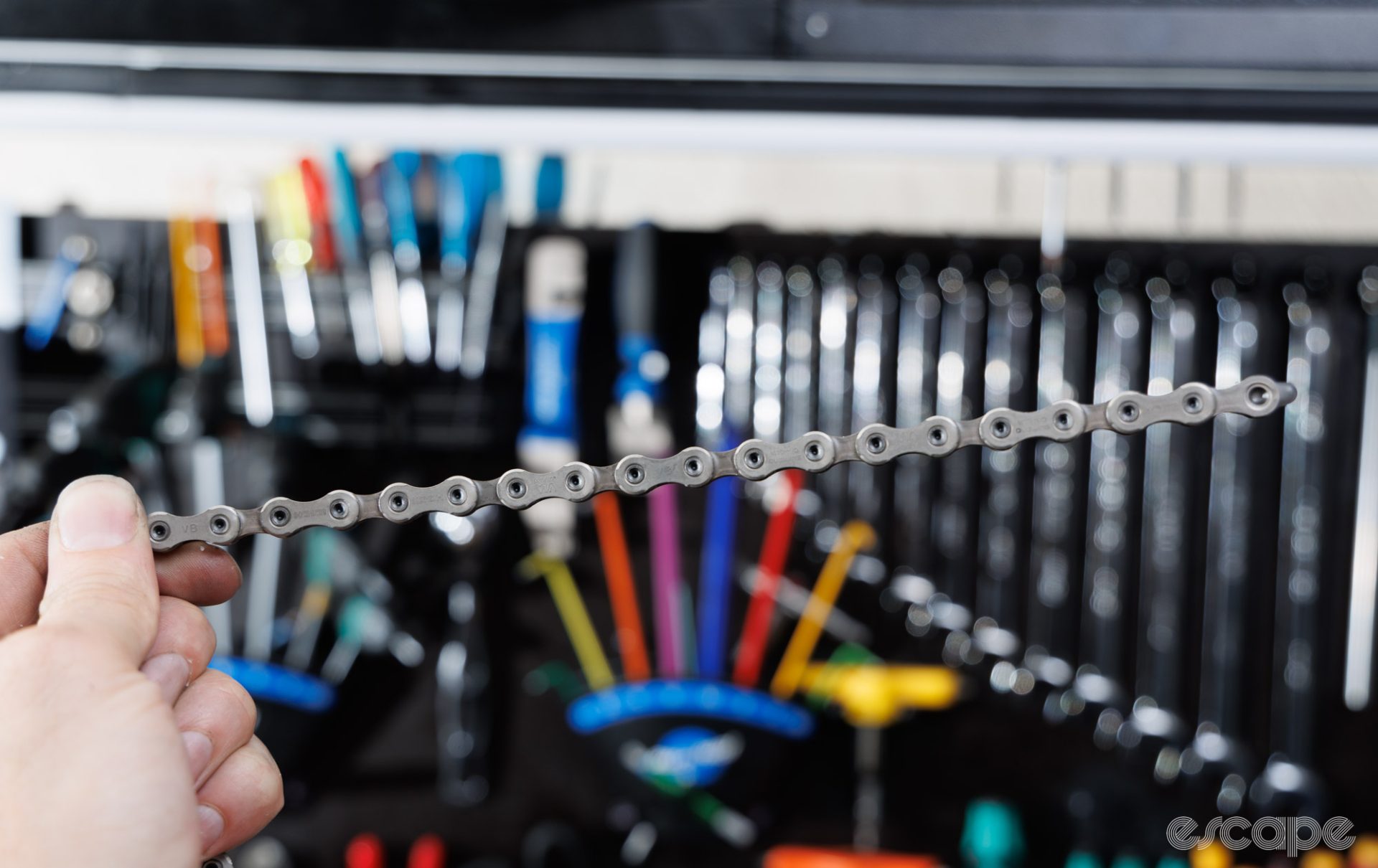

I repeated the test, the second time with a fresh SRAM T-Type XX SL chain and another block of the StripChip. And once again, the result was the same. A chain that now felt slick and no longer greasy to touch, but one where the links weren’t rigid or requiring breaking-free.
At this point, it’s worth noting that adding more fresh wax into the pot would change the ratio of unicorn-teared grease to wax. Using less wax (say 200 grams) will provide worse results. Add more wax, and you’ll probably get closer to that fresh rigid hold for which hot submersion wax is known.
It was suggested that a durometer could be used to measure the hardness of the wax at room temperature. After the second chain/chip, my Shore A durometer measured that the StripChip’d wax had varying hardness across the top. Meanwhile, the unharmed wax revealed more consistent figures. That said, the Shore A durometer used is better suited to measuring slightly firmer materials than wax, while a Shore OO durometer is ideally needed here, so please take this finding with a pinch of SuperSecret salt.
Unfortunately, a short timeframe and thunderstorms mean I’m yet to complete any form of back-to-back durability testing. Early impressions off-road are that the StripChip’d SRAM chain isn’t collecting dust or grit – a good and impressive sign given how tacky the factory grease is.

Whether the StripChip’d wax is slower or reduces the wax durability is unknown until trusted independent tests, such as from Zero Friction Cycling, appear. In the meantime, Silca is keeping tight-lipped on its data, but teased testing shows chains waxed with StripChip are just as fast as traditionally waxed chains.
At this early stage, I’m left with a spell of intrigue and scepticism. I think Silca’s StripChip does something, enough to still be a superior choice to most drip lubes, and, therefore, is a great option for those wanting to wax without the prep. Still, it’s obvious the factory grease isn’t just magically disappearing into the atmosphere, so at least for now, I still recommend that the wax curious buy a pre-waxed chain or do some one-off degreaser-in-jar shaking.
A new waxing station
Launching alongside the StripChip, Silca has also unveiled its “Ultimate Chain Wax System,” a self-contained heating station that seemingly aims to stop people scrolling through Amazon in search of forever smaller slow cookers.
While consumer chain wax products have been available for several years, the thing that melts the wax has remained a do-it-yourself thing. The common method is a small off-the-shelf slow cooker (aka crockpot), while others have found success in using sous vide bags (something Silca’s wax is packaged in), hair removal wax heaters, or even just careful stovetop cooking.
At the end of 2022, CycloWax launched a turn-key solution with a dedicated waxing station, the wax, and all other accessories. CycloWax is a late entrant into the wax world, but it brought a point of difference with a turn-key heating solution. Now, Silca is joining in and has launched its version with a similar form, including a digitally temperature-controlled heating bath beneath a hanging stand.
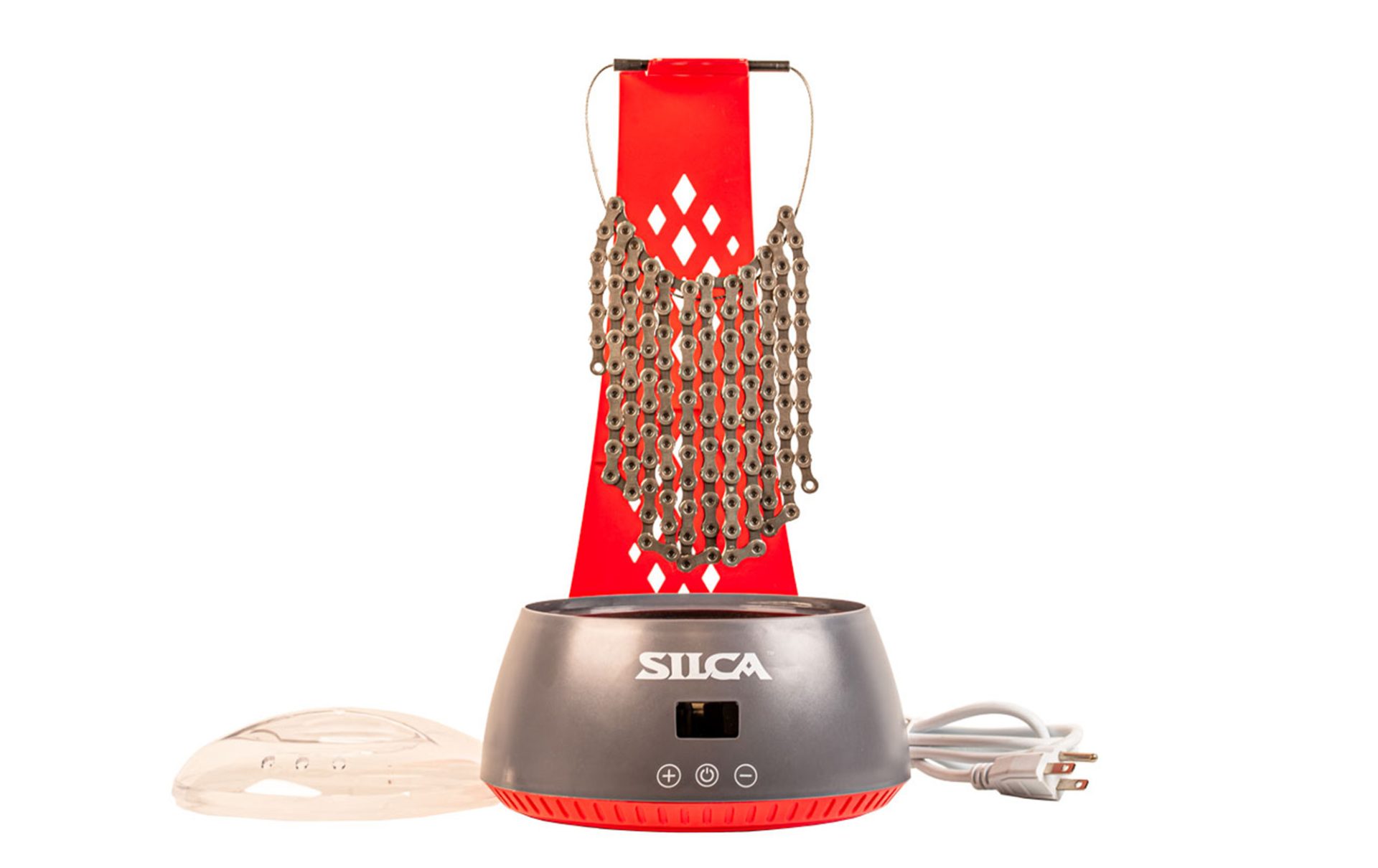
Silca claims its system provides a larger wax pot (600 mL capacity) for easier chain placement than a hair removal wax heater. A small threaded cable is given to assist with keeping the chain together and aid in hanging it to dry. The unit turns itself on at a preset 75°C (considered the ideal for Silca’s Secret Blend wax), with the temperature easily customised and controlled from there. These will be offered globally with suitable regional plugs; in the case of my future test sample, the Australian plug version is still a month or so away.
Expect to pay US$99 / £99 / €119 for Silca’s chain wax system, a price that does not include the needed bag of wax.
Collective testing
The price point and concept of Silca’s StripChip means I suspect many will buy to try, and I’m keen to hear the experiences of others. Bigger picture, this is the first iteration of such a product in cycling, and it’s sure to lead to some fascinating developments. Watch this space.
What did you think of this story?

